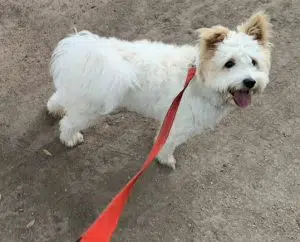
Intervertebral disc disease in dogs (IVDD) is a painful and debilitating condition involving the cushioning discs (intervertebral discs) between the vertebrae of the spinal column.
In IVDD affected dogs, the normally gelatinous intervertebral discs either bulge or burst into the spine cord space. There isn’t much space around the spinal cord so it doesn’t take much for the wayward disc to start pressing against the spinal cord itself. This results in pain, nerve damage and, if allowed to progress untreated, paralysis.
Some breeds are more prone than others with Dachshunds, Beagles and Basset Hounds at the top of the list.
If the spinal cord is compressed, the messages normally sent along its path are blocked leading to a range of symptoms depending on the severity and level of spinal cord compression. Symptoms of Intervertebral disc disease in dogs include:
IVDD is categorised into Type 1 and Type 2. Type 1 involves a hardening and increased brittleness of the outer layer of the disc and Type 2 is a generalised hardening of the disc over time. Jumping or landing can trigger rupture of a Type 1 disc, this is common in the neck of smaller breeds.
My beloved Chihuahua cross Bella (who lived to the ripe old age of 21 bless her tiny heart!) had IVDD, which was sparked every time someone rang the door bell. She would be in agony after her impulsive tirade at the door, walking around like she was wearing an invisible neck brace until the pain could be relieved with medications, warm compresses and massages. Eventually Bella had surgery to correct the bulging disc and she never looked back, which brings us to the next point.
Diagnosis of Intervertebral disc disease in dogs involves an initial examination by your veterinarian to determine the source of pain and degree of neurological deficits.
Depending on the severity of symptoms and location of the damaged disc, your vet may prescribe anti-inflammatories and strict rest for milder cases, and imaging and emergency surgery for more severe cases. As you can imagine, the spinal cord is pretty unforgiving and if the pressure isn’t relieved rapidly, permanent and devastating damage can occur.
Surgery is quite specialised and involves cutting a window into the adjacent vertebrae to relieve the pressure on the spinal cord. Prompt diagnosis and surgery vastly improve the prognosis, as does an effective rehabilitation plan.
Mild cases may recur and eventually require surgery, as was the case with my dog Bella. In cases where damage to the spinal cord isn’t reversed rapidly, permanent hind leg paralysis may occur. Affected dogs can still go onto have a good quality of life and their mobility is greatly improved with a custom made cart however prevention is obviously far better than the cure.
At risk breeds should be dealt with carefully when it comes to jumping and landing, harnesses, ramps and maintaining a low body weight can also help. As for breeding, IVDD affected dogs shouldn’t be reproducing due to congenital nature of the condition.
For more information about other common joint injuries in dogs CLICK HERE.
About the Author: Dr Melissa Meehan is a highly experienced and respected veterinary surgeon with over 14 years experience. Dr Melissa obtained her Members in Small Animal Medicine through examination in 2008 and now runs her own veterinary ophthalmology service.

The role of moisture in dog food


Walking a dog – how much and why

Tips for exercising a dog indoors

Exercising puppies – how much do they need?


Get your paws on Lara Shannon’s best selling books ‘Eat, Play, Love (your dog) and World of Dogs.
Available in Australia, USA, UK and Canada.